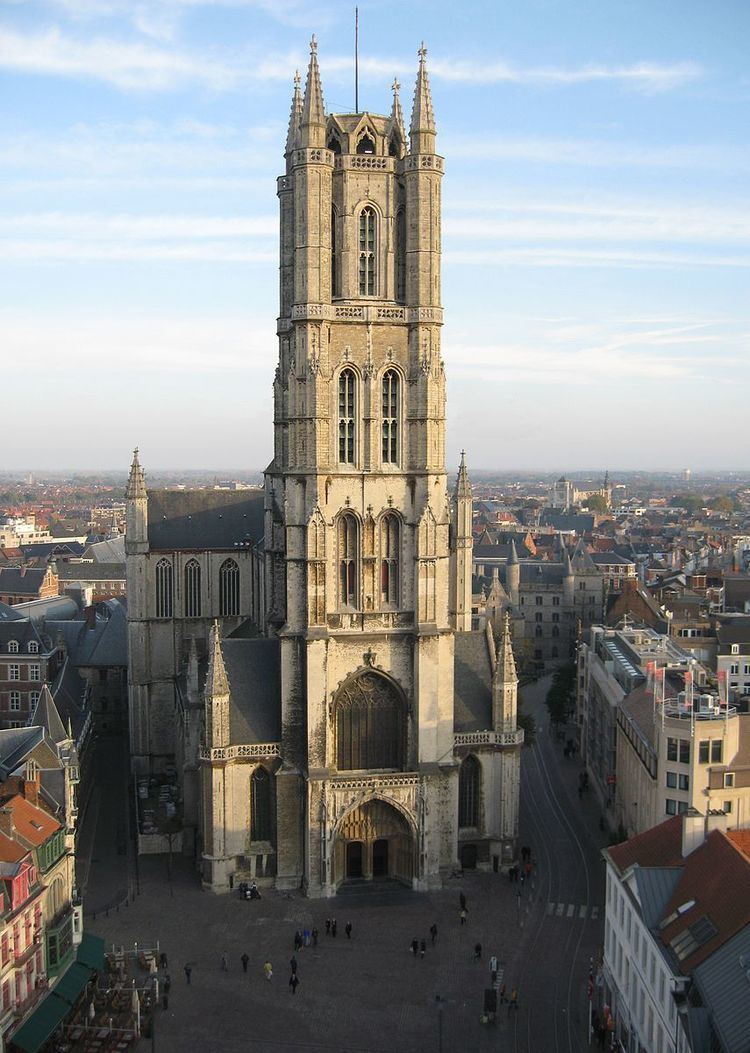Height 89 m Phone +32 9 269 20 45 | Opened 942 AD | |
 | ||
Architectural styles Burials Ignace Schetz de Grobbendonk Similar Gravensteen, Saint Nicholas' Church, Ghent City Museum, Graslei, St Michael's Bridge | ||
Not to be confused with the cathedral in Haarlem, Netherlands
Contents
- Saint bavo cathedral in ghent
- Description
- Ghent Altarpiece
- Other artwork
- Chapter of Saint Bavo
- Burials
- References
The Saint Bavo Cathedral (also known as Sint-Baafs Cathedral, or in Dutch Sint Baafskathedraal) an 89m-tall Gothic cathedral in Ghent, Belgium. It is the seat of the diocese of Ghent. It is named for Saint Bavo of Ghent.
Saint bavo cathedral in ghent
Description
The building is built on the site of the former Chapel of St. John the Baptist, a primarily wooden construction that was consecrated in 942 by Transmarus, Bishop of Tournai and Noyon. Traces of this original structure are evident in the cathedral's crypt.
The chapel was subsequently expanded in the Romanesque style in 1038. Some traces of this phase of expansion are still evident in the present day crypt.
In the subsequent period from the 14th through 16th centuries, nearly continuous expansion projects in the Gothic style were executed on the structure. A new choir, radiating chapels, expansions of the transepts, a chapter house, nave aisles and a single tower western section were all added during this period. Construction was considered complete June 7, 1569.
In 1539, as a result of the rebellion against Charles V, the old Abbey of St. Bavo was dissolved. Its abbot and monks went on to become canons in a Chapter that was attached to what then became the Church of Saint Bavo. When the Diocese of Ghent was founded in 1559, the church became its cathedral. The church of Saint Bavo was earlier the site of the baptism of Charles V.
Ghent Altarpiece
The cathedral is noted for the Ghent Altarpiece, originally in its Joost Vijd chapel. It is formally known as: The Adoration of the Mystic Lamb by Hubert and Jan van Eyck. This work is considered Van Eyck's masterpiece and one of the most important works of the early Northern Renaissance, as well as one of the greatest artistic masterpieces of Belgium. Several of the painting's wings were bought in 1816 by the English collector in Berlin, Edward Solly. They were bought in 1821 by the King of Prussia, Frederick William III and continued to be kept in Germany. During World War I, other panels were taken from the cathedral by Germany. As part of mandated compensation in the Versailles Treaty after the end of the war, Germany returned the pilfered panels along with the original panels that had been legitimately bought by Solly, to help compensate for other German "acts of destruction" during the war.
The Germans "bitterly resented the loss of the panels", and at the start of another conflict in 1940, a decision was made in Belgium to send the painting to the Vatican to keep it safe. The painting was en route to the Vatican, in France, when Italy declared war as an Axis power alongside Germany. The painting was stored in a museum in Pau for the duration of the war, as French, Belgian and German military representatives signed an agreement which required the consent of all three before the masterpiece could be moved. In 1942, Adolf Hitler ordered the painting to be seized and brought to Germany to be stored in a Bavarian castle. After Allied air raids made the castle too dangerous for the painting, it was stored in a salt mine. Belgian and French authorities protested the seizing of the painting, and the head of the German army's Art Protection Unit was dismissed after he disagreed with the seizure.
Other artwork
The cathedral is home to works of other artists of note. It holds the painting Saint Bavo enters the Convent at Ghent by Peter Paul Rubens. The Calvary Triptych is a 15th-century work attributed to Justus van Gent. There are also works by or after Lucas de Heere, one of which is a View of Gent. Frans Pourbus the Elder painted 14 panels representing the History of Saint Andrew (1572) and a Triptych of Viglius Aytta (1571). Caspar de Crayer is represented by paintings of St Macarius of Gent, The Beheading of Saint John the Baptist and The Martyrdom of Saint Barbara. The church also holds works by Antoon van den Heuvel including the Christ and the Adulterous Woman and the Resurrection of Christ. There are also works by Lucas van Uden and Jan van Cleef.
Highlights of the interior decoration of the cathedral include the Baroque high altar (1702–1782), in white, black and red flamed marble, the rococo pulpit (1741–1745), made in oak, gilded wood and white and black marble by Laurent Delvaux, with wrought iron fence by J. Arens, the tomb monuments of Ghent bishops, including that of Antonius Triest, in white and black marble (1652–1654), a major work of Jerôme Duquesnoy (II), finally, a valuable collection of silverware and liturgical vestments.
There are also chairs designed by the contemporary designer Maarten Van Severen.
Chapter of Saint-Bavo
Still today the chapter is housed inside the cathedral, sincd its foundation. Members have been import prelats and members of noble houses. Today Jozef De Kesel is one of the honorary canons.
